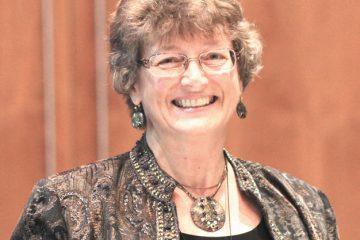Between the cracks
Myths and Misconceptions series
The Jewish Family Identity Forum with Candace R. Kwiatek, The Dayton Jewish Observer

My father-in-law, Jack Kwiatek of blessed memory, had an unusual habit when out for a walk: he would scrutinize the sidewalk cracks.
Why, you might ask, as I did on numerous occasions — usually when I was in a hurry.
He would always answer, “Because that’s where the most interesting things can be found.”
On the afternoon before he passed away, he showed me his favorite acquisitions from a recent family trip to the Bahamas, recounting again how “he found these interesting treasures between the cracks.”
I see in Jack’s final words a very important message. We spend our time building great edifices, pursuing notable achievements, and acquiring significant rewards from our hard work. And that’s all good, when done justly.
But the most interesting things in life are often found elsewhere, between the cracks. And sometimes that’s where the most significant things are found in the Torah as well.
What are the first things that come to mind when you think about the biblical tales? Great edifices like the pyramids and palaces of Egypt? Notable achievements as in Joseph’s rise to power in Potiphar’s court and Moses’ successful leadership across the wilderness?
Significant rewards, such as the covenant with Abraham and the elevation of Joshua to command?
These are the events we typically visualize: the big picture, the storyline of the Israelite saga.
And if you ask the same question of a random assortment of passersby, nine times out of 10 their answers will mirror yours. Edifices. Achievements. Rewards. And all male characters.
I’m no classical feminist. But multiple readings of the biblical stories do seem to reinforce the stereotype of grand male-centered sagas with women in limited supporting roles. Then again, what might we discover about biblical women by peering between the cracks?
Eve
In Genesis 2, we read that Eve is created to complete Adam, to provide his corresponding other half (ezer k’negdo).
Shortly thereafter in the garden scene with the serpent (Gen. 3), Eve is seemingly portrayed as gullible and guilty, not a particularly complimentary other half.
Only by looking between the cracks at those same chapters do we begin to appreciate Eve’s real qualities. Adam, the rule-follower, is content with the status quo and apparently unmoved by his choices.
Eve, on the other hand, is a values-pursuer, seeing wisdom as desirable even above obedience or eternal life.
Adam stands silent (right next to Eve, according to the Hebrew text), while Eve engages with challenging ideas and the possibility of change and growth.
Ultimately, in her choice to eat the forbidden fruit, Eve elevates humans by imparting to them the more godlike capacity for knowing good and evil and making moral choices.
As a consequence, Rabbi Yitzchak Hirshfeld suggests, Eve also impels God to insert mercy (rachamim from the Hebrew word rechem, womb) into the imperfect world to balance judgment (din).
Eve between the cracks: she’s a rather amazing other half.
Hagar
In Genesis 16, when the pregnant Hagar runs away into the wilderness, God’s messenger comes to comfort and encourage her, promising a bright future for her offspring and assuring her that God has taken notice of her difficulties. Hagar then names God El Roi (God of Seeing).
In this short scene between the cracks, Hagar accomplishes a number of biblical firsts. Long before the Exodus, she introduces the idea that God takes special note of the downtrodden, the unprotected, the needy, and those of whom society takes no notice.
This theme will later be echoed in the oft-repeated refrains, “Remember that you were slaves in Egypt,” and “Do not oppress the stranger, the orphan or the widow in your midst.”
Through Hagar, we learn that God loves and protects all people, not just the Chosen People, reinforcing the message that chosen does not mean superior.
When she names God (the only person in the Bible to do so), Hagar also introduces the notion of the all-seeing God, a significant theme of the Jewish High Holy Days season.
Hagar between the cracks: she enlightens us about God.
Dinah
“Now Dinah, the daughter whom Leah had born to Jacob, went out to visit the women of the land (Gen. 34).”
In that single sentence, the self-assured, inquisitive, friendly and outgoing Dinah sets into motion a series of events that echoes into the future.
The rest of Dinah’s story — the princely seduction, her brothers’ promises of marriage, circumcision through trickery, and a vengeful murder of the men of Shechem — is like a chain of dominoes as her brothers’ (Simon and Levi) destructive responses undermine two tribal lines instead of building a new community.
On his deathbed, Jacob curses the brothers for their anger and resultant revenge killing, stripping them of blessing and birthright and minimizing their tribal portions in Israel.
With the first three of Jacob’s sons out of the running for leadership, it falls to Judah to inherit.
From this tribe, the kings of Israel and the Messiah will arise. This tribe will also give its name to the Israelites: Judahites or Jews.
Dinah between the cracks: she sets in motion events that will establish the reign of Judah’s kings, the ancestry of the Messiah, and the very name of the people of Israel: Jews.
While the biblical plotline generally features the patriarchs with their obvious edifaces, achievements, and rewards, behind the scenes, biblical women quietly go about their lives making significant contributions and having far-reaching impacts.
It is just as a wise man once told me: it’s between the cracks where the most interesting things can be found. We just have to remember to look.
Family Discussion: What surprised you when looking between the cracks? What do you discover when looking deeper into the stories of other biblical women?
Literature to share
In Praise of Intransigence: The Perils of Flexibility by Richard Weisberg. Using examples from history, religion, and current events, this short scholarly work challenges the notions that flexibility and compromise are always good. Weisberg suggests that a sense of emergency and a culture of open-mindedness often lead us to unwisely abandon our most closely-held values and traditions. An unexpected and worthwhile discovery. Recommended for serious adult readers and book groups interested in provocative subject matter.
Chik Chak Shabbat by Mara Rockliff. A delightfully modern Shabbat tale, Chik Chak celebrates varied traditions, friendships, and the value of caring. The simple lyrics and amusing illustrations are perfect for engaging the preschool and kindergarten set. Try making the vegetarian cholent recipe at the back of the book.
To read the complete January 2015 Dayton Jewish Observer, click here.



